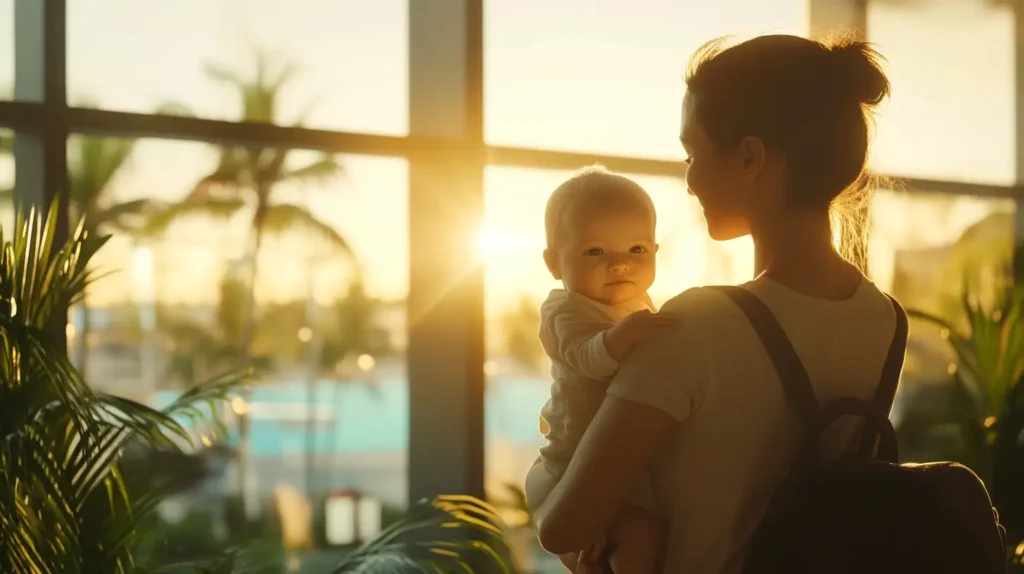Table of Contents
ToggleTiny Travelers’ Guide: How I Survived Jet-Setting with a Newborn (And How You Can Too!)
Have you ever found yourself staring at your sleeping baby, thinking about that dream vacation you’ve been putting off, and wondering if those two worlds could ever peacefully collide? Let me tell you something that might sound a little crazy – traveling with your tiny human isn’t just possible; it can actually be enjoyable when you know the secrets.
Three months after our little one arrived, my partner and I faced a family wedding in Barbados. Everyone thought we were absolutely mad. You’re taking a three-month-old where? But here’s what I discovered: the more people told me it couldn’t be done, the more determined I became to prove them wrong.
In this post, I’m going to share with you something I really wish someone had told me sooner – the practical strategies that transformed our travel experience from potential nightmare to memorable adventure. These aren’t just theoretical ideas; these are battle-tested techniques from someone who’s been through the airport security line with a screaming infant and lived to tell the tale.
The biggest mistake most parents make? They think that preparing more, worrying more, and stressing more will somehow make things work out. We believe if we just pack enough diapers, formula, and backup onesies, everything will go smoothly. I’m not saying preparation isn’t important – it absolutely is – but what I’ve learned is that your mindset matters even more than what’s in your suitcase.
So if you’re ready to stop putting your life on hold just because you’ve added a tiny passenger to your journey, keep reading. Because in about 10 minutes, I’m going to completely change how you think about traveling with your little one.
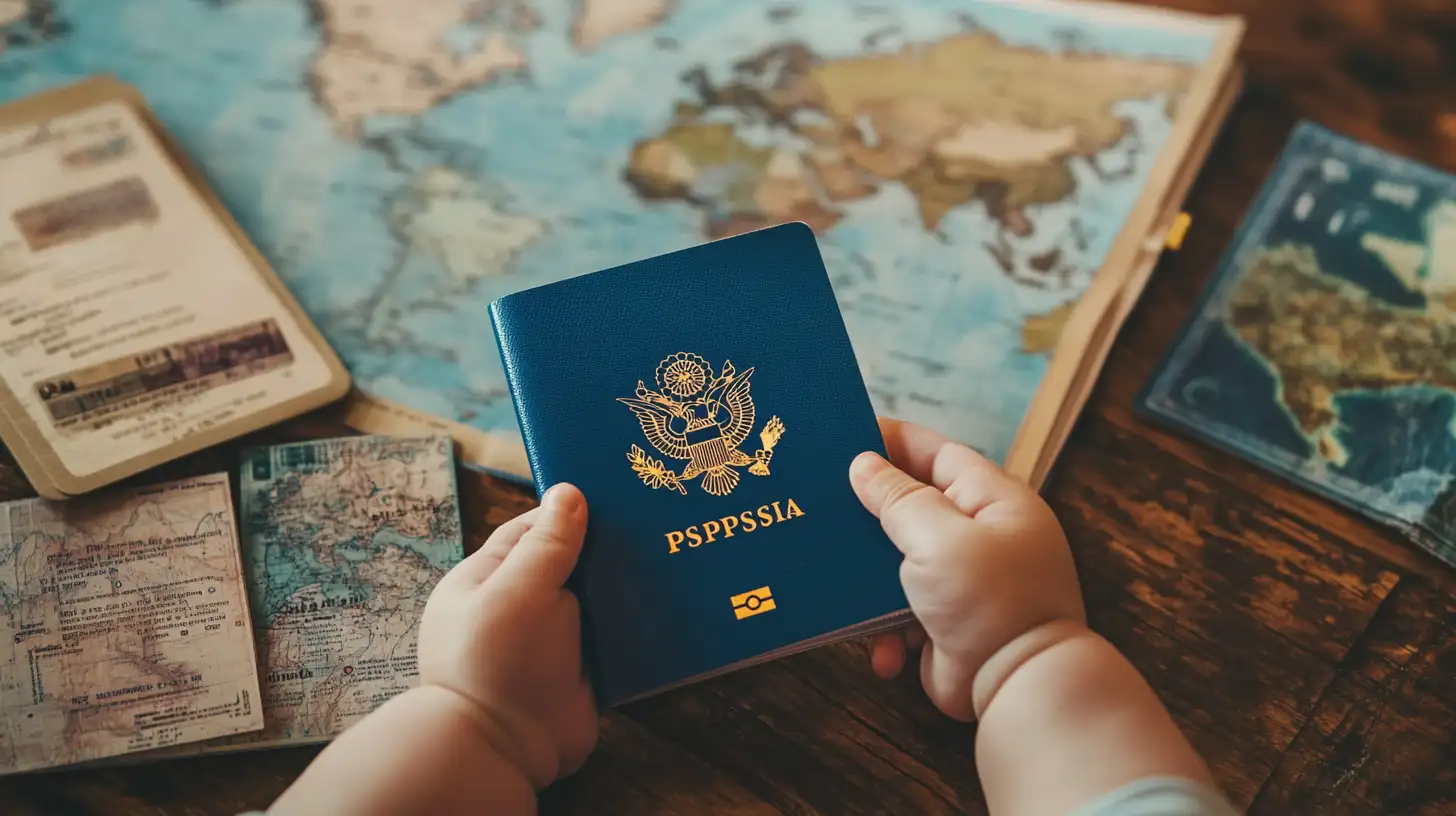
Documentation Drama: Getting Your Tiny Human Travel-Ready
Let me start with something that nearly derailed our first family trip before it even began. Two days before our departure, I realized we hadn’t actually confirmed whether our baby needed a passport. I’d assumed since she was so small and would be sitting on our laps, maybe she could just be included on one of ours. Let me save you that particular panic attack – every human, regardless of how tiny, needs their own travel documents.
Here’s what you need to know about documentation:
- Apply for your baby’s passport well in advance – at least 2-3 months before travel if possible. Those cute passport photos with their little confused expressions? They take longer than you think to get right.
- For international travel, check if you need a birth certificate in addition to a passport. Some countries require both.
- If you’re traveling solo with your baby, bring a notarized letter from the other parent giving permission. This isn’t just a suggestion – border agents can and do ask for this.
- Make digital copies of all documents and store them in a cloud service you can access from your phone. When you’re juggling a baby, diaper bag, and your own exhaustion, having backups is a lifesaver.
I used to overthink everything about documentation. What if they don’t accept our application? What if there’s a problem at the border? What if I forgot something important? But in reality, caring too much about perfect documentation was just holding me back from even planning the trip.
When I finally let go of the idea that everything had to be perfectly in order and just focused on getting the essential documents secured, that’s when things started falling into place. The passport office was actually incredibly helpful with infant applications, and border agents were far more understanding than I’d feared.
Remember, if you’ve done what you can with the documentation, you’ve already won the first battle of family travel. And if something isn’t perfect? There’s always a solution. Trust me on this one.
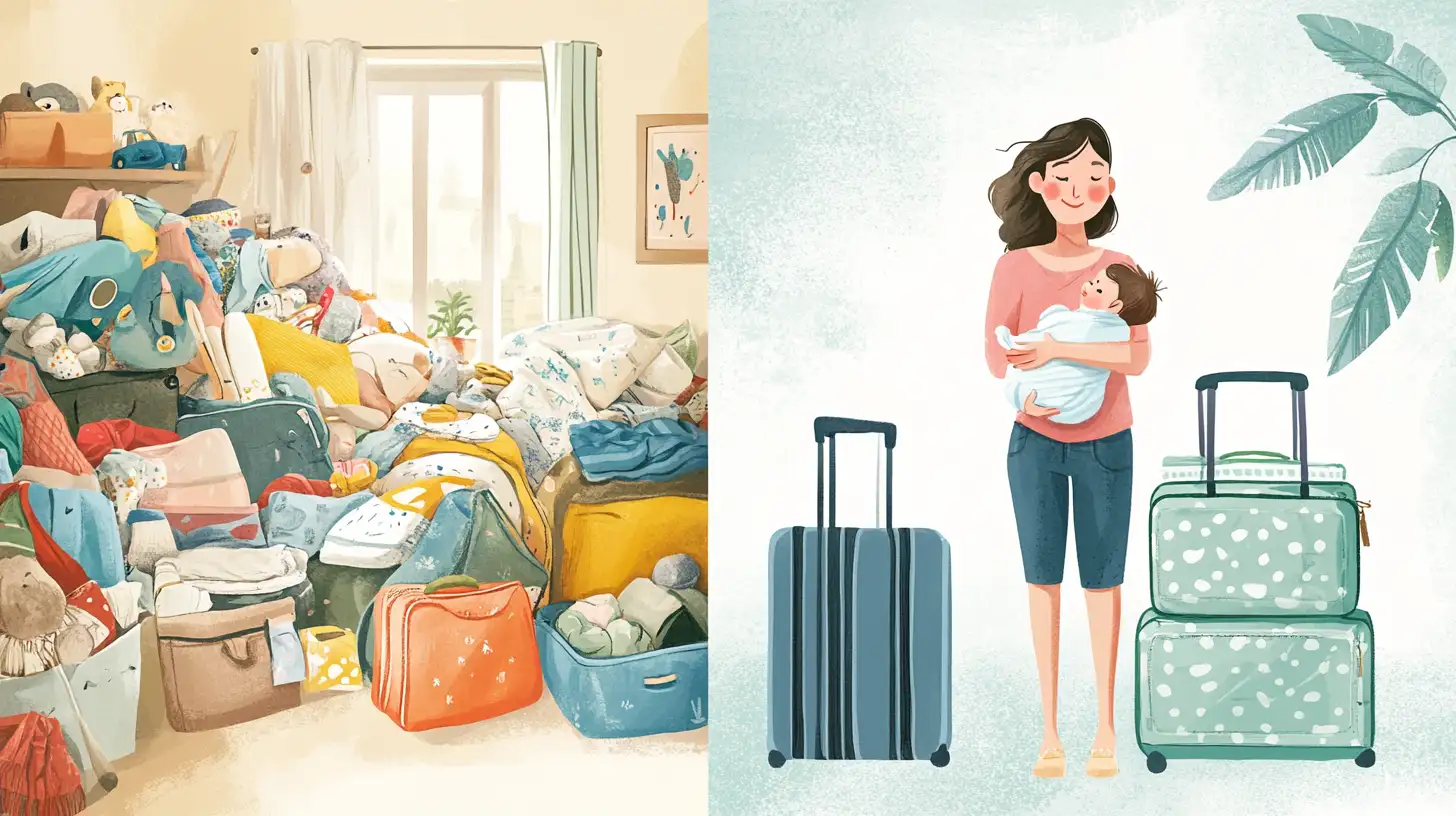
Packing Paradise: The Art of Bringing Everything While Packing Light
The first time I packed for our baby, I literally tried to fit her entire nursery into our luggage. I was convinced we would need every single item she had ever touched or might possibly need in the future. Five outfit changes per day? Obviously necessary. Every medication in the baby aisle? Couldn’t leave home without them.
Three hours into packing, with our bedroom looking like a baby store had exploded, my partner gently suggested we might be overthinking things. And that’s when it hit me – I was packing out of fear, not necessity.
Here’s the liberating truth I discovered: babies need far less than we think they do, and most destinations have stores where you can buy emergency supplies if needed. What actually matters is having a core set of essentials and the freedom to move without breaking your back.
My bare minimum packing list now includes:
- Diapers and wipes for 2 days, plus one full pack in checked luggage (you can buy more at your destination)
- One outfit per day plus 3 extras (not 5 per day like I originally packed)
- Basic first aid including infant fever reducer, thermometer, and any prescription medications
- Their favorite comfort item – for us, it’s a small muslin blanket that smells like home
- Portable white noise machine – this tiny device saved our sanity in unfamiliar sleeping environments
- Foldable baby carrier – easier than lugging a stroller through airport security
What I don’t pack anymore? A separate suitcase just for toys. A full-size baby bathtub. Every piece of baby equipment we own. Because here’s what I learned in Barbados – my baby was perfectly happy playing with a plastic cup and sitting in a regular bathtub with a hand towel as cushioning.
The irony here is that once I stopped trying to recreate our entire home environment while traveling, both my baby and I became calmer and more adaptable. When you’re not weighed down by excessive baggage – both physical and mental – you move differently. You show up more present, more relaxed, and more able to enjoy the adventure.
And that’s when the magic of family travel really begins.
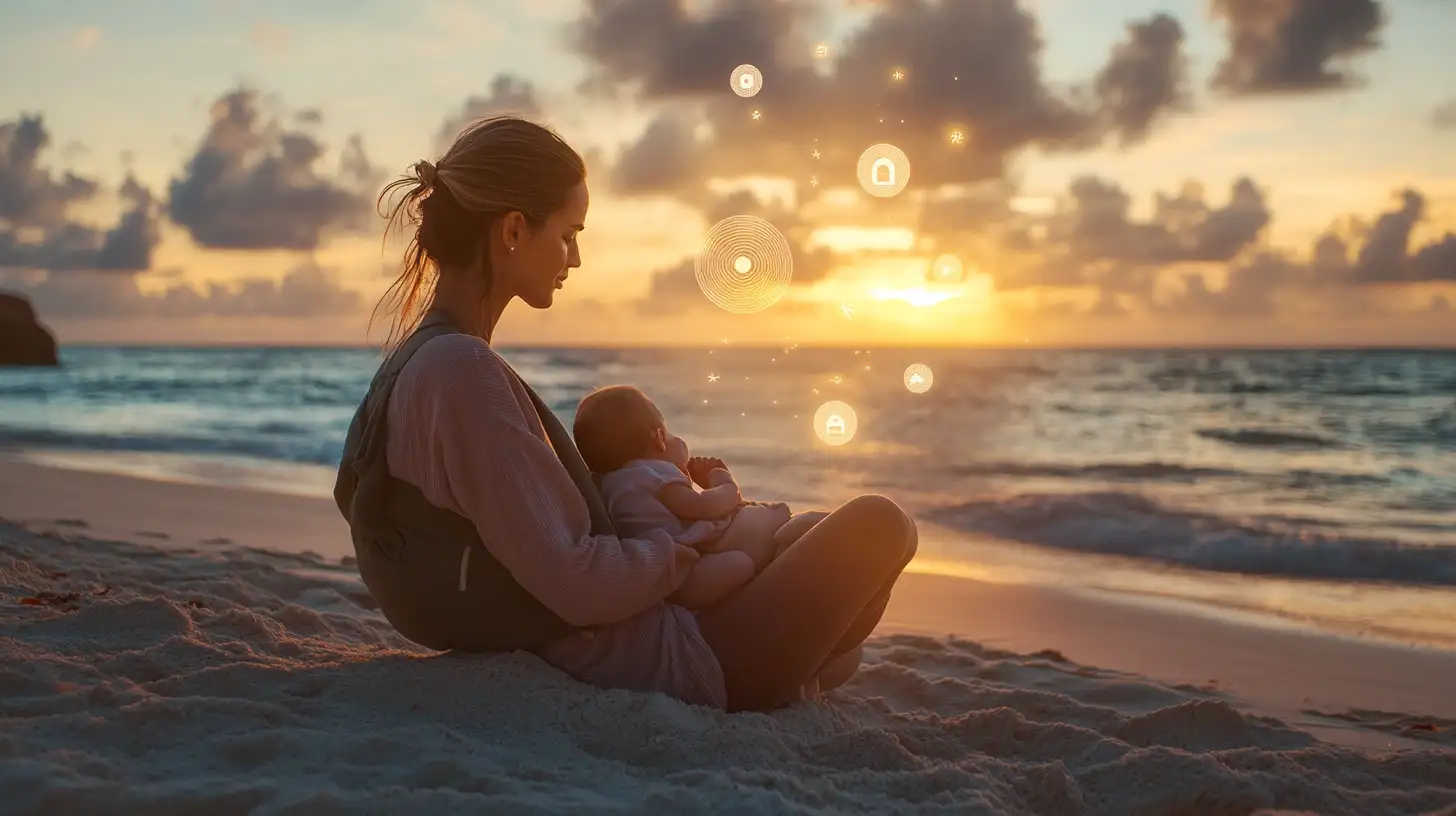
Schedule Sorcery: Adapting Routines Without Losing Your Mind
If you’re anything like I was, your baby’s schedule is basically sacred text. Their nap times, feeding times, and bedtime routines have been established through weeks of careful observation and adjustment. The thought of disrupting this delicate balance is enough to make any parent break out in a cold sweat.
So when we were planning our first trip, my biggest anxiety wasn’t the flight or even the packing – it was what would happen to our precious schedule. Would we return home to a tiny sleep-deprived monster whose routines were irreparably damaged?
Here’s what I learned about schedules and travel: they will be disrupted, and that’s actually okay. The key isn’t maintaining the exact same schedule – it’s having a flexible framework that you can adapt to new environments.
I now approach travel schedules with what I call the anchor point method:
- Identify 2-3 anchor points in your day that remain consistent (for us, it’s morning wake-up routine, pre-nap ritual, and bedtime routine)
- Be flexible about everything else, including exact timing
- Shift gradually to the new time zone by adjusting these anchor points by 30 minutes each day
- Create a mini-version of home routines that can be replicated anywhere (our bedtime routine simplified to three steps: washcloth wipe-down, sleeper, same lullaby)
In Barbados, we discovered something surprising – babies are often more adaptable than we give them credit for. The sound of ocean waves actually helped our little one sleep better than her normal white noise machine. The tropical heat meant she was perfectly comfortable in just a diaper for most of the day, which made changes and clean-ups easier.
What I thought would be the hardest part of traveling with a baby turned out to be one of the most illuminating. I realized that what my baby needed wasn’t a rigid schedule – it was a present parent who could respond to her needs in the moment.
The freedom from perfect schedules gave us both room to breathe and enjoy our surroundings. And that’s when I truly embraced the with-or-without-it energy – the feeling that we were going to enjoy this trip regardless of whether naps happened at exactly 9:30 AM and 2:00 PM.
Because here’s the truth: when you get back home, babies are remarkably good at slipping back into their familiar routines. That fear of permanently destroying their schedule? It’s just another story we tell ourselves to justify our anxiety.
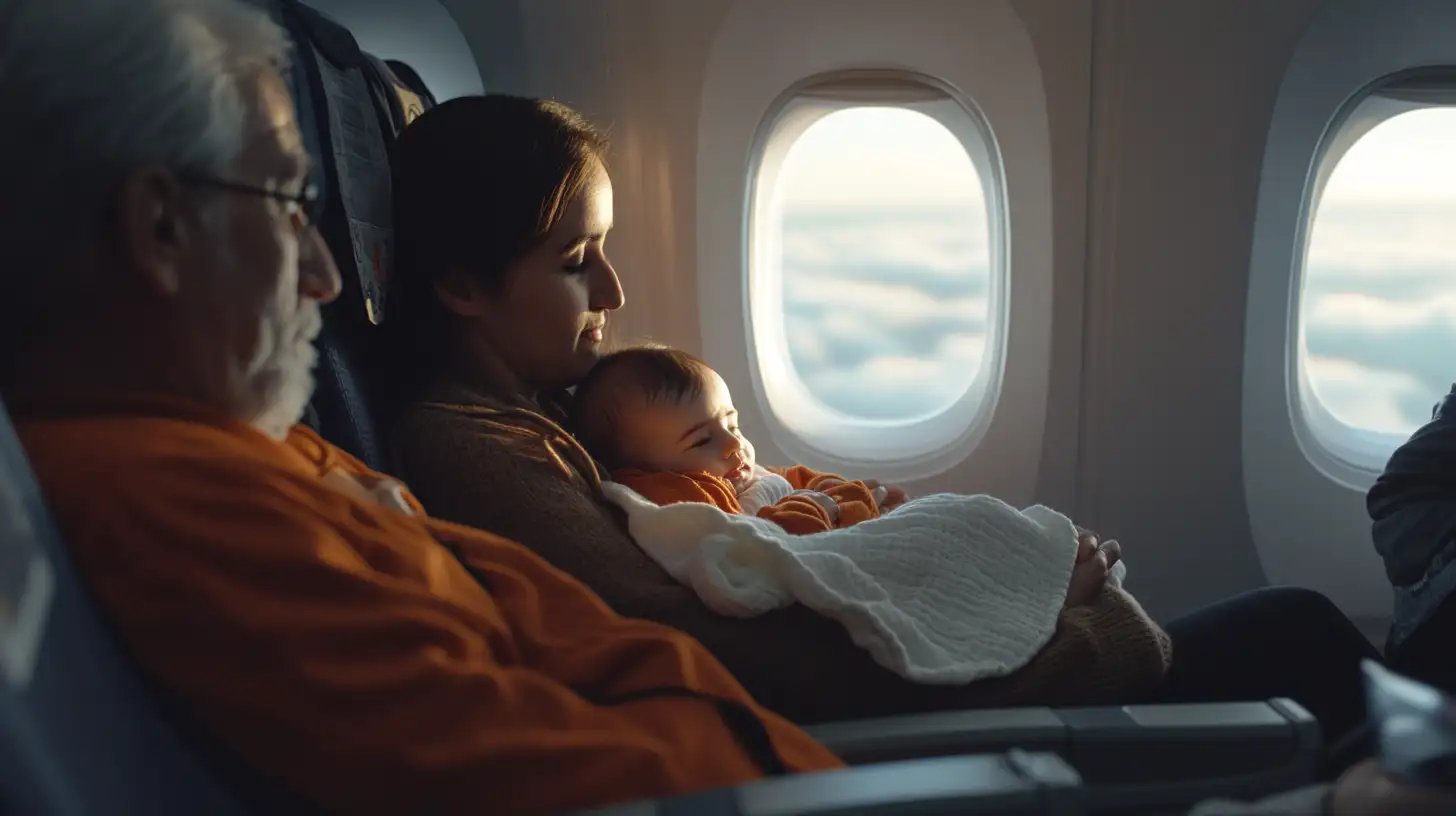
Flight Fundamentals: Surviving Transit Without Becoming a Meme
My biggest fear before our first flight wasn’t that something terrible would happen – it was that we’d become those parents with the screaming baby that the entire plane silently (or not so silently) judges. I had actual nightmares about angry passengers and flight attendants giving us the death stare.
So I researched obsessively. I read every article, joined every parent travel forum, and practically interviewed flight attendants whenever I saw them in public. And yes, I packed enough supplies in my carry-on to survive being stranded on a desert island with a baby.
But what I discovered on that first eight-hour flight to Barbados wasn’t what I expected.
First, most people were far kinder than I anticipated. An elderly gentleman across the aisle actually offered to hold our baby while I ate. A flight attendant showed me a quiet corner where I could stand and bounce her when she got fussy.
Second, the things that worked weren’t always what the experts recommended. Here’s what actually made a difference:
- Booking a window seat so I could lean against it while nursing (much more comfortable than the middle or aisle)
- Bringing a lightweight muslin blanket to create a semi-private nursing cover and block light for naps
- Nursing or offering a pacifier during takeoff and landing to help with ear pressure
- Wearing easily removable layers – planes can go from freezing to boiling with no warning
- Accepting help when offered by flight crew or kind strangers (this was hard for my perfectionist self!)
The most powerful realization came halfway through our flight. After changing a diaper in the tiny airplane bathroom (an Olympic-level feat), I returned to find my baby happily being entertained by the passenger next to us. In that moment, I understood that I didn’t need to do everything perfectly or handle everything alone.
When I stopped caring about whether people would judge me, I became more confident. When I stopped worrying about being the perfect traveling parent, I became more competent. The detachment from others’ opinions and from perfect outcomes actually made me more capable of handling whatever came up.
And guess what? My baby wasn’t the loudest on the plane. Not even close. Because babies can sense our anxiety, and when I calmed down, she did too.

Sleep Survival: Creating Rest Havens Anywhere in the World
If there’s one thing that strikes fear into the heart of every new parent, it’s the prospect of sleep disruption. At home, we’d finally established a bedtime routine that worked most nights. The thought of throwing all that hard work away for a vacation seemed almost reckless.
Our first night in Barbados confirmed my worst fears. The unfamiliar crib, the different sounds and smells, the lingering excitement of travel – it all combined to create what I can only describe as a sleep disaster. After two hours of trying to get our little one down, I sat on the floor of our hotel room and cried right along with her.
That’s when my partner suggested something that changed everything: What if we stop trying to recreate home and instead create a new sleep experience that works for this environment?
This mindset shift was revolutionary. Instead of fighting against our new reality, we embraced it and found creative solutions:
- We moved the hotel crib next to our bed and removed one side, creating a safer co-sleeping arrangement that gave our baby the closeness she needed in an unfamiliar place
- We discovered that the bathroom fan made excellent white noise and left it running all night
- We established a new, simplified bedtime routine with just three steps that could be done anywhere
- We became more flexible about nap locations – our baby ended up taking some of her best naps in the baby carrier while we walked along the beach
The Caribbean approach to babies also taught me something valuable. The local families we met had a much more relaxed attitude toward baby sleep. Babies were included in evening activities, napped when they were tired, and generally adapted to the family’s life rather than the other way around.
By our third night, something magical happened. Our baby not only went to sleep easily but stayed asleep longer than she typically did at home. The gentle ocean breeze through the window, the rhythmic sound of waves, and my own more relaxed demeanor created a sleep environment that worked better than our carefully controlled nursery at home.
This experience taught me that babies are remarkably resilient and adaptable when we give them the chance. What matters isn’t recreating the exact sleep conditions of home – it’s creating a sense of safety and consistency within change.
And sometimes, the new sleep strategies you discover while traveling even improve your routine when you return home. We certainly brought back the practice of more outdoor time before bed and a simplified routine that focused on connection rather than perfect execution.
Beyond Survival: Embracing the Journey
The most profound lesson I learned through traveling with my tiny human wasn’t about the perfect packing list or the ideal flight time. It was about who I became in the process.
Before we took that first trip, I was a parent ruled by fear and perfectionism. I believed that if I just controlled every variable, anticipated every problem, and planned for every scenario, I could guarantee a perfect experience. I was exhausted from trying to be the perfect parent with the perfect baby on the perfect schedule.
But traveling stripped away that illusion of control. In the airport with a suddenly hungry baby and no privacy to nurse, in the hotel with a crib that didn’t meet my expectations, on the beach with a diaper blowout and limited supplies – I had to adapt. I had to let go. I had to trust that whatever happened, we would figure it out together.
And in that letting go, I found freedom. Freedom from the anxiety that had characterized my early parenting months. Freedom from the need for everything to go according to plan. Freedom to actually enjoy the present moment with my baby instead of constantly worrying about what might go wrong next.
What I want you to take from this isn’t just a list of travel tips (although I hope those are helpful). It’s the permission to see travel with your baby not as an obstacle course to be perfectly navigated but as an opportunity for growth – for both of you.
Your baby doesn’t need a perfect travel experience. They need a parent who is present, adaptable, and calm enough to respond to whatever comes up. And when you let go of the idea that you can and should control everything, you become exactly the parent they need.
The irony here is that when you stop trying so hard to make everything perfect, that’s when things start to fall into place. When you embrace the chaos instead of fighting it, you discover that most challenges are temporary and solvable.
So the next time someone raises their eyebrows when you mention traveling with your baby, smile and remember this: the parents who don’t let having a baby stop them from exploring the world are the ones raising adaptable, resilient children. And the memories you’ll create together? They’re worth every moment of imperfection along the way.
Because if you’ve shown up, if you’ve tried, if you’ve given your all to making this experience work for your family – then you’ve already won, regardless of how many naps were missed or how many outfit changes were needed along the way.
Are you ready to pack those bags and show your tiny human the big, beautiful world out there? Trust me, you’ve got this – and it’s going to be an adventure worth taking.
Step into Sue Brown's World of Baby Care, where you'll find a treasure trove of knowledge and wisdom waiting to be explored. Sue's dedication to providing accurate and up-to-date information on baby care shines through in every article, blog post, and resource she shares. From newborn essentials to sleep training tips, breastfeeding advice to nurturing your baby's development, Sue covers a wide range of topics that are essential for every parent to know. Her warm and compassionate approach creates a sense of community and reassurance, making her website a safe haven for parents seeking guidance and support. Let Sue Brown be your partner in this beautiful journey of parenthood, as she empowers you to create a loving, nurturing, and thriving environment for your little one.
- Indoor Air Quality for Infant Respiratory Health - October 20, 2025
- Positive Discipline Foundations: Setting the Stage From Infancy - October 18, 2025
- 2025’s Most Innovative Baby Products Worth the Investment - October 16, 2025

